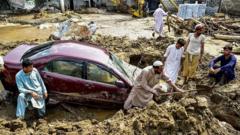More than 200 people are currently missing in the Buner district of north-west Pakistan due to catastrophic flooding and landslides associated with extreme monsoon rains. As officials reported, the recent floods have claimed the lives of over 300 people in Pakistan and Pakistan-administered Kashmir. The most significant impacts have occurred in the mountainous province of Khyber Pakhtunkhwa.
A local official from Buner confirmed to the BBC that 209 individuals are still unaccounted for, with fears that this number could rise. Rescue teams have unfortunately buried eight unidentified bodies, as there have been no relatives present to claim them, according to Jehangir Khan from the deputy commissioner's office. The destruction of roads has further complicated efforts for families trying to locate lost loved ones.
A provincial spokesperson for disaster management noted that "10 to 12 entire villages" have been partially buried under debris. In the neighboring Shangla district, dozens are also reported missing. Monsoon rains, which typically occur between June and September and provide most of South Asia's annual rainfall, have been intensified by climate change, leading to increased frequency and severity of landslides and flash floods.
The rains have also been impactful across the border in Indian-administered Kashmir, where at least 60 fatalities were reported due to similar flooding. In Pakistan-administered Kashmir, nine people lost their lives this week, and another five in the northern region of Gilgit-Baltistan.
Meteorologists predict that heavy rainfall will continue until August 21 in the northwestern areas, some of which have been declared disaster zones. Pakistan has wrestled with the effects of this year's monsoon season since June, with at least 650 fatalities attributed to severe weather events.
Notably, Punjab, home to nearly half of Pakistan's population, experienced a concerning 73% increase in rainfall compared to the previous year, resulting in a larger death toll than seen in the entire last monsoon season. The region, known for its glaciers, is also experiencing rapid ice melt due to climate change, a phenomenon that is destabilizing mountain faces and contributing to landslide risks. While the specific causes behind the recent floods remain uncertain, experts believe that melting ice could be a significant factor.
A local official from Buner confirmed to the BBC that 209 individuals are still unaccounted for, with fears that this number could rise. Rescue teams have unfortunately buried eight unidentified bodies, as there have been no relatives present to claim them, according to Jehangir Khan from the deputy commissioner's office. The destruction of roads has further complicated efforts for families trying to locate lost loved ones.
A provincial spokesperson for disaster management noted that "10 to 12 entire villages" have been partially buried under debris. In the neighboring Shangla district, dozens are also reported missing. Monsoon rains, which typically occur between June and September and provide most of South Asia's annual rainfall, have been intensified by climate change, leading to increased frequency and severity of landslides and flash floods.
The rains have also been impactful across the border in Indian-administered Kashmir, where at least 60 fatalities were reported due to similar flooding. In Pakistan-administered Kashmir, nine people lost their lives this week, and another five in the northern region of Gilgit-Baltistan.
Meteorologists predict that heavy rainfall will continue until August 21 in the northwestern areas, some of which have been declared disaster zones. Pakistan has wrestled with the effects of this year's monsoon season since June, with at least 650 fatalities attributed to severe weather events.
Notably, Punjab, home to nearly half of Pakistan's population, experienced a concerning 73% increase in rainfall compared to the previous year, resulting in a larger death toll than seen in the entire last monsoon season. The region, known for its glaciers, is also experiencing rapid ice melt due to climate change, a phenomenon that is destabilizing mountain faces and contributing to landslide risks. While the specific causes behind the recent floods remain uncertain, experts believe that melting ice could be a significant factor.


















